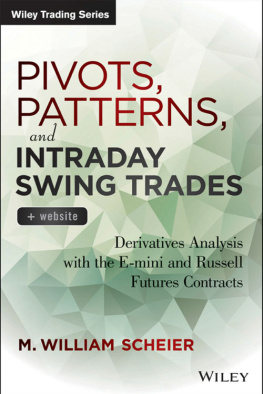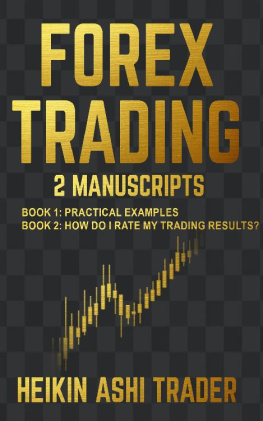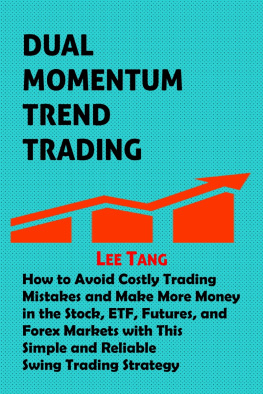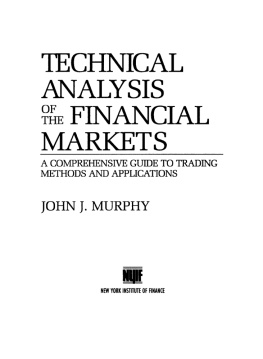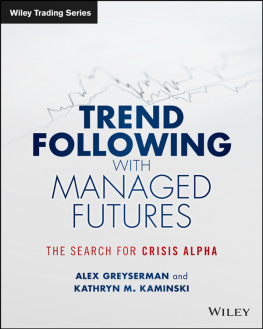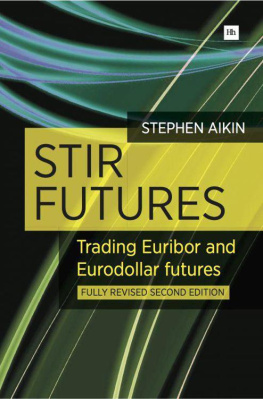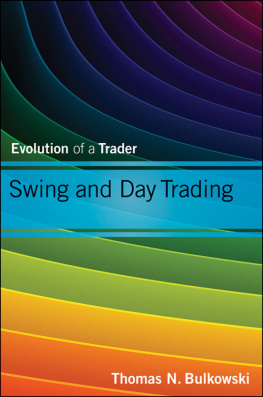P IVOTS ,
P ATTERNS,
AND I NTRADAY
S WING T RADES
Founded in 1807, John Wiley & Sons is the oldest independent publishing company in the United States. With offices in North America, Europe, Australia and Asia, Wiley is globally committed to developing and marketing print and electronic products and services for our customers' professional and personal knowledge and understanding.
The Wiley Trading series features books by traders who have survived the market's ever changing temperament and have prosperedsome by reinventing systems, others by getting back to basics. Whether a novice trader, professional or somewhere in-between, these books can provide the advice and strategies needed to prosper today and well into the future.
For more on this series, visit our website at www.WileyTrading.com .
P IVOTS ,
P ATTERNS,
AND I NTRADAY
S WING T RADES
Derivatives Analysis with the E-mini
and Russell Futures Contracts
M. William Scheier
ValhallaFutures.com

Cover Design: Wiley
Cover Image: iStockphoto.com / epic11
Copyright 2014 by M. William Scheier. All rights reserved.
Published by John Wiley & Sons, Inc., Hoboken, New Jersey.
All charts wherein courtesy of Ninjatrader.com
All data courtesy of Kinetic, a subsidiary of Ninjatrader.com
Published simultaneously in Canada.
No part of this publication may be reproduced, stored in a retrieval system, or transmitted in any form or by any means, electronic, mechanical, photocopying, recording, scanning, or otherwise, except as permitted under Section 107 or 108 of the 1976 United States Copyright Act, without either the prior written permission of the Publisher, or authorization through payment of the appropriate per-copy fee to the Copyright Clearance Center, Inc., 222 Rosewood Drive, Danvers, MA 01923, (978) 750-8400, fax (978) 646-8600, or on the Web at www.copyright.com . Requests to the Publisher for permission should be addressed to the Permissions Department, John Wiley & Sons, Inc., 111 River Street, Hoboken, NJ 07030, (201) 748-6011, fax (201) 748-6008, or online at http://www.wiley.com/go/permissions .
Limit of Liability/Disclaimer of Warranty: While the publisher and author have used their best efforts in preparing this book, they make no representations or warranties with respect to the accuracy or completeness of the contents of this book and specifically disclaim any implied warranties of merchantability or fitness for a particular purpose. No warranty may be created or extended by sales representatives or written sales materials. The advice and strategies contained herein may not be suitable for your situation. You should consult with a professional where appropriate. Neither the publisher nor author shall be liable for any loss of profit or any other commercial damages, including but not limited to special, incidental, consequential, or other damages.
For general information on our other products and services or for technical support, please contact our Customer Care Department within the United States at (800) 762-2974, outside the United States at (317) 572-3993 or fax (317) 572-4002.
Wiley publishes in a variety of print and electronic formats and by print-on-demand. Some material included with standard print versions of this book may not be included in e-books or in print-on-demand. If this book refers to media such as a CD or DVD that is not included in the version you purchased, you may download this material at http://booksupport.wiley.com . For more information about Wiley products, visit www.wiley.com .
Library of Congress Cataloging-in-Publication Data:
Scheier, M. William.
Pivots, patterns and intraday swing trades : derivatives analysis with the e-mini and Russell futures contracts / M. William Scheier.
pages cm. (Wiley trading series)
Includes bibliographical references and index.
ISBN 978-1-118-77579-0 (cloth); ISBN 978-1-118-77586-8 (ebk); ISBN 978-1-118-77584-4 (ebk)
1. Technical analysis (Investment analysis) 2. Speculation. 3. StocksCharts, diagrams, etc. 4. Derivative securities. I. Title.
HG4529.S35 2014
332.645dc23
2013038867
Dedicated to the memory of Randolph Newman,
and to his wonderful granddaughter Glenny,
who saw in me something of merit
when I was a young man.
PREFACE
M y initial efforts in trading were focused almost exclusively on what is known as position trading , using equities and the physical commodity futures. Stretched out over the days and weeks a position could last, a trend in that time frame would eventually begin to make sense in technical terms, unfolding gradually as it proceeded on. There was a pace to the decision process. As a trader, one could mull over the conflicting elements of the technical picture. Some aspects would recede into the background and render themselves less relevant; some would grow in their importance and become glaring.
Initial forays into day trading stock index futures reveal a starkly different decision environment. There is no time to dwell on technical conditions. A day trade opportunity does not take shape over days and weeks. Opposing technical signals don't recede in time enough to sweep away the cross current of doubts before a decision is required. By the time a trend finally makes sense, it is often about to end. Intraday volatility in the stock indices is far more exaggerated than the daily bar charts of other markets, partly due to the extreme leverage, partly due to the intense participation. And positioning techniques that survive in the action of the long-term trends in other instruments get slaughtered in the countertrend reactions of the highly leveraged S&P 500 futures contract within the short term.
When starting out, understanding the day as it unfolded on a day trading scale was akin to trying to read a foreign language or decipher a secret code. Somehow the tremendous opportunities in these intraday trend swings were surely being captured successfully, but by whom?
The less-experienced student will often assume that floor traders in the pit capture the intraday swings. After all, those guys must be in the know. Their access is so immediate. They literally create price. That being out therehanging 10 on the leading edge to the rhythm of historymust provide a better view, and information not otherwise available to the rest of us must be streaming across the pit at critical moments, providing the insight to decipher the head fakes from the real trend swings. One could easily come to the conclusion that because these guys are the professionals, they must surely make up that slim minority who are consistently taking the profits from those less skilled working off-floor on their video screens.
But nothing could be further from the truth. Floor traders are, for the most part, scalpers. They tend to front-run or fade the order flow. To them, swing trading intraday trends would be position trading. I was also surprised to learn that the majority of floor traders see the world from the point of view of Efficient Market Theorists, admittedly or not. For floor traders, if paper flow into the pit is the current of energy driving the markets, then it is the news and news events that provide the power supply for that energy. Why should they believe otherwise, given their worldview!
Nor is the S&P pit in Chicago the bastion of capitalism and free trade one might think it to be. The number of Efficient Market Practitioners on the floor of the futures exchange is only surpassed by the number of pit traders whose politics reveal an inclination toward unionism, trade regulation, intervention, and controls. Remarks from otherwise very talented traders actually reveal the belief that it was one U.S. President's tenure or another that caused a difficult period of market activity or a particularly beneficial one. With thinking like that underlying the operations of the S&P pit, how much insight is to be garnered there for a conceptual understanding of market trend structure? The theory of Random Walk never had more adamant proponents.

